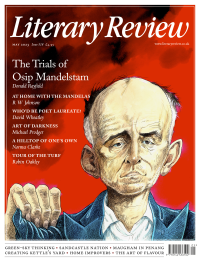Norma Clarke
Running Free
In Her Nature: How Women Break Boundaries in the Great Outdoors
By Rachel Hewitt
Chatto & Windus 528pp £25
In a specialist running shop, Rachel Hewitt was told that the reason there are lots of shoes for men and only a few specifically designed for women, whose bodies need different shoes, is because women running is ‘a really recent thing’, something that began ‘around 1975’, and kit designers are playing catch-up. Questioning these assumptions, Hewitt started to research women as runners and in the outdoors more generally: as hikers, mountaineers and rock climbers. She discovered a harsh truth. There were Victorian women who climbed, hiked, tobogganed, skated and ran before 1975. There are photographs to prove it. But in the early 20th century, as these pursuits became codified and institutionalised, men started to make women feel unwelcome. Pierre de Coubertin, founder of the modern Olympic Games, declared women’s sport to be ‘against the laws of nature’. The Olympic spirit was to be the ‘exaltation of male athleticism … with the applause of women as the reward’.
Some of the photographs were taken by Lizzie Le Blond, an Anglo-Irish ‘lady mountaineer’, author, photographer and filmmaker, as well as the founder and first president of the Ladies’ Alpine Club. Born in 1860, Le Blond was, for one thing, ‘the best-known woman mountain climber of her time’, making ascents in heavy Victorian skirts – which got heavier as they got wetter. She also took her cumbersome camera equipment with her. In the Swiss Alps, she photographed scenes of female athletes roped together, peering down crevasses, sledging and scrambling up ridges. So far from being ‘against the laws of nature’, climbing in the mountains provided mental and physical release for women. Le Blond had been sick with suspected tuberculosis and was first sent to the Alps for a ‘rest-cure’, leaving behind her husband and newly born son. She didn’t look back. There were to be two more husbands but no more children or wifely domesticity (her son was brought up by her mother). The mountains, she wrote, knocked from her ‘the shackles of conventionality’, and she was grateful. She settled in St Moritz and her chosen companions were the guides who led her up mountains and sport-loving women like herself. She became a keen tennis player, reaching the women’s final of the first Swiss Lawn Tennis Championship in 1895. She took up cycling too – of course she did: in the 1890s cycling did more ‘to emancipate women than anything else in the world’, the women’s rights activist Susan B Anthony declared.
Hewitt weaves Le Blond’s story through her impassioned history of women’s experiences in the ‘great outdoors’. She sets out to solve two puzzles. How could a woman like Le Blond, a prolific writer who was ‘often profiled in women’s magazines’, have become so obscure? And how and why did

Sign Up to our newsletter
Receive free articles, highlights from the archive, news, details of prizes, and much more.@Lit_Review
Follow Literary Review on Twitter
Twitter Feed
Though Jean-Michel Basquiat was a sensation in his lifetime, it was thirty years after his death that one of his pieces fetched a record price of $110.5 million.
Stephen Smith explores the artist's starry afterlife.
Stephen Smith - Paint Fast, Die Young
Stephen Smith: Paint Fast, Die Young - Jean-Michel Basquiat: The Making of an Icon by Doug Woodham
literaryreview.co.uk
15th-century news transmission was a slow business, reliant on horses and ships. As the centuries passed, though, mass newspapers and faster transport sped things up.
John Adamson examines how this evolution changed Europe.
John Adamson - Hold the Front Page
John Adamson: Hold the Front Page - The Great Exchange: Making the News in Early Modern Europe by Joad Raymond Wren
literaryreview.co.uk
"Every page of "Killing the Dead" bursts with fresh insights and deliciously gory details. And, like all the best vampires, it’ll come back to haunt you long after you think you’re done."
✍️My review of John Blair's new book for @Lit_Review
Alexander Lee - Dead Men Walking
Alexander Lee: Dead Men Walking - Killing the Dead: Vampire Epidemics from Mesopotamia to the New World by John Blair
literaryreview.co.uk